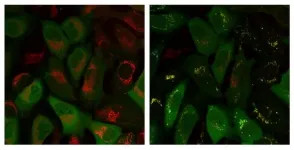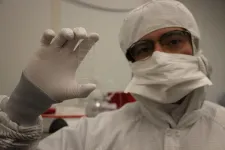(Press-News.org) LA JOLLA--(April 7, 2021) When cells are stressed, chemical alarms go off, setting in motion a flurry of activity that protects the cell's most important players. During the rush, a protein called Parkin hurries to protect the mitochondria, the power stations that generate energy for the cell. Now Salk researchers have discovered a direct link between a master sensor of cell stress and Parkin itself. The same pathway is also tied to type 2 diabetes and cancer, which could open a new avenue for treating all three diseases.
"Our findings represent the earliest step in Parkin's alarm response that anyone's ever found by a long shot. All the other known biochemical events happen at one hour; we've now found something that happens within five minutes," says Professor Reuben Shaw, director of the NCI-designated Salk Cancer Center and senior author of the new work, detailed in Science Advances on April 7, 2021. "Decoding this major step in the way cells dispose of defective mitochondria has implications for a number of diseases."
Parkin's job is to clear away mitochondria that have been damaged by cellular stress so that new ones can take their place, a process called mitophagy. However, Parkin is mutated in familial Parkinson's disease, making the protein unable to clear away damaged mitochondria. While scientists have known for some time that Parkin somehow senses mitochondrial stress and initiates the process of mitophagy, no one understood exactly how Parkin was first sensing problems with the mitochondria--Parkin somehow knew to migrate to the mitochondria after mitochondrial damage, but there was no known signal to Parkin until after it arrived there.
Shaw's lab, which is well known for their work in the fields of metabolism and cancer, spent years intensely researching how the cell regulates a more general process of cellular cleaning and recycling called autophagy. About ten years ago, they discovered that an enzyme called AMPK, which is highly sensitive to cellular stress of many kinds, including mitochondrial damage, controls autophagy by activating an enzyme called ULK1.
Following that discovery, Shaw and graduate student Portia Lombardo began searching for autophagy-related proteins directly activated by ULK1. They screened about 50 different proteins, expecting about 10 percent to fit. They were shocked when Parkin topped the list. Biochemical pathways are usually very convoluted, involving up to 50 participants, each activating the next. Finding that a process as important as mitophagy is initiated by only three participants--first AMPK, then ULK1, then Parkin--was so surprising that Shaw could scarcely believe it.
To confirm the findings were correct, the team used mass spectrometry to reveal precisely where ULK1 was attaching a phosphate group to Parkin. They found that it landed in a new region other researchers had recently found to be critical for Parkin activation but hadn't known why. A postdoctoral fellow in Shaw's lab, Chien-Min Hung, then did precise biochemical studies to prove each aspect of the timeline and delineated which proteins were doing what, and where. Shaw's research now begins to explain this key first step in Parkin activation, which Shaw hypothesizes may serve as a "heads-up" signal from AMPK down the chain of command through ULK1 to Parkin to go check out the mitochondria after a first wave of incoming damage, and, if necessary, trigger destruction of those mitochondria that are too gravely damaged to regain function.
The findings have wide-ranging implications. AMPK, the central sensor of the cell's metabolism, is itself activated by a tumor suppressor protein called LKB1 that is involved in a number of cancers, as established by Shaw in prior work, and it is activated by a type 2 diabetes drug called metformin. Meanwhile, numerous studies show that diabetes patients taking metformin exhibit lower risks of both cancer and aging comorbidities. Indeed, metformin is currently being pursued as one of the first ever "anti-aging" therapeutics in clinical trials.
"The big takeaway for me is that metabolism and changes in the health of your mitochondria are critical in cancer, they're critical in diabetes, and they're critical in neurodegenerative diseases," says Shaw, who holds the William R. Brody Chair. "Our finding says that a diabetes drug that activates AMPK, which we previously showed can suppress cancer, may also help restore function in patients with neurodegenerative disease. That's because the general mechanisms that underpin the health of the cells in our bodies are way more integrated than anyone could have ever imagined."
INFORMATION:
About the Salk Institute for Biological Studies:
Every cure has a starting point. The Salk Institute embodies Jonas Salk's mission to dare to make dreams into reality. Its internationally renowned and award-winning scientists explore the very foundations of life, seeking new understandings in neuroscience, genetics, immunology, plant biology and more. The Institute is an independent nonprofit organization and architectural landmark: small by choice, intimate by nature and fearless in the face of any challenge. Be it cancer or Alzheimer's, aging or diabetes, Salk is where cures begin. Learn more at: salk.edu.
New medicines for people who have diabetes seem to pop up all the time. Drugs that help the body break down carbohydrates, drugs that increase excretion of glucose in the urine, drugs that help muscles respond to insulin and drugs that stimulate the pancreas to produce it -- the list of pharmaceutical options to treat diabetes gets longer and longer.
The downside of this wealth of treatment options is that it can be difficult for health care providers to stay on top of the latest research and standards of care. Which medication is best for which patients? And what are the best medicines to prescribe that both lower blood glucose and reduce risk for cardiovascular disease?
Johns Hopkins Medicine endocrinologist ...
How many species of birds are there in the world? It depends on whose count you go by. The number could be as low as 10,000 or as high as 18,000. It's tough to standardize lists of species because the concept of a "species" itself is a little bit fuzzy.
That matters because conserving biodiversity requires knowing what diversity exists in the first place. So biologists, led by University of Utah doctoral candidate Monte Neate-Clegg of the School of Biological Sciences, set out to compare four main lists of bird species worldwide to find out how the lists differ--and why. They found that although the lists agree on most birds, disagreements in some regions ...
A new analysis of lung epithelial cells from COVID-19 patients reveals how the protective complement branch of the immune system, which usually plays roles in both innate and adaptive immunity, can convert to a harmful system during COVID-19. Blocking excessive complement activity in lung epithelial cells with a combination of existing chemotherapy and antiviral medications - ruxolitinib and remdesivir, respectively - helped normalize the production of complement proteins by infected lung epithelial cells in human cell culture experiments, the researchers found. Thus, the drug duo could serve as a promising strategy to treat damaging inflammation during severe COVID-19, the authors say. Overactivation of complement proteins can contribute to diseases such as acute respiratory distress ...
HERSHEY, Pa.-- Social distancing and lockdowns may have reduced the spread of COVID-19, but researchers from Penn State College of Medicine also report those actions may have affected clinical researchers' ability to finish trials. Study completion rates dropped worldwide between 13% and 23%, depending on the type of research sponsor and geographic location, between April and October 2020.
Researchers previously reported that more than 80% of clinical trials suspended between March 1 and April 26, 2020, noted the pandemic as their chief reason for halting activity. Patient enrollment in studies was lower in April 2020, compared to April ...
WYOMISSING, Pa. -- Teaching people to become entrepreneurs requires more than just passing on entrepreneurial skills, according to a team of Penn State Berks-led researchers. Would-be entrepreneurs also need to understand -- and negotiate -- the barriers that they might face.
In a study, researchers built a multidimensional model to measure the effectiveness of entrepreneurship education. The model not only includes teaching entrepreneurial skills, but also addresses the students' intentions to start a business and their perceptions of the barriers they might encounter when starting a business.
"There are a lot of studies in the literature that focus on, for example, how entrepreneurship education ...
HOUSTON -- (April 7, 2021) -- Rice University computer scientists have demonstrated artificial intelligence (AI) software that runs on commodity processors and trains deep neural networks 15 times faster than platforms based on graphics processors.
"The cost of training is the actual bottleneck in AI," said Anshumali Shrivastava, an assistant professor of computer science at Rice's Brown School of Engineering. "Companies are spending millions of dollars a week just to train and fine-tune their AI workloads."
Shrivastava and collaborators from Rice and Intel will present research that addresses that bottleneck April 8 at the machine learning systems conference MLSys.
Deep neural networks ...
In an article published in the April 8 issue of Nature, the National Institutes of Health's Somatic Cell Gene Editing Consortium provided a detailed update on the progress of their nationwide effort to develop safer and more effective methods to edit the genomes of disease-relevant somatic cells and reduce the burden of disease caused by genetic changes.
Gene editing allows scientists to modify sections of an organism's DNA and is considered a promising treatment for a number of genetic diseases. There have been numerous advances in the laboratory over the last few decades, but there are still many challenges to overcome before gene editing can be widely used in the patient population. Launched in 2018, the Somatic Cell Gene Editing Consortium ...
A natural brilliant blue coloring has been discovered by an international team of researchers including chemists at the University of California, Davis. The new cyan blue, obtained from red cabbage, could be an alternative to synthetic blue food colorings such as the widely used FD&C Blue No. 1. The work is published April 7 in Science Advances.
"Blue colors are really quite rare in nature - a lot of them are really reds and purples," said Pamela Denish, a graduate student working with Professor Justin Siegel at the UC Davis Department of Chemistry and Innovation Institute for Food and Health.
Having ...
Scientists have developed a long-sought naturally derived cyan blue colorant sourced from red cabbage anthocyanin pigments that may offer an alternative to the industry standard blue dye, although more testing is needed to determine the compound's safety. The novel colorant, which was developed using an enzyme that converts a range of anthocyanins to one with the ideal wavelength, remains highly stable over time and may also produce better green colors than those derived from existing natural blue colorants. Several research programs around the world are dedicated to the hunt for a natural alternative to FD&C Blue No.1 - a challenging effort given that cyan blue is one of the rarest colors in nature. While previous research has shown that ...
DURHAM, N.C. -- An interdisciplinary team of scientists at Duke University has developed a highly sensitive and rapid diagnostic test for Ebola virus (EBOV) infection. In monkeys infected with Ebola, this diagnostic, called the D4-assay, proved to be 1000 times more sensitive than the currently approved rapid diagnostic test and capable of detecting the virus a full day earlier than the gold standard polymerase chain reaction (PCR) test.
This work, which appears in Science Translational Medicine on April 7, was done by biomedical engineers, molecular ...




